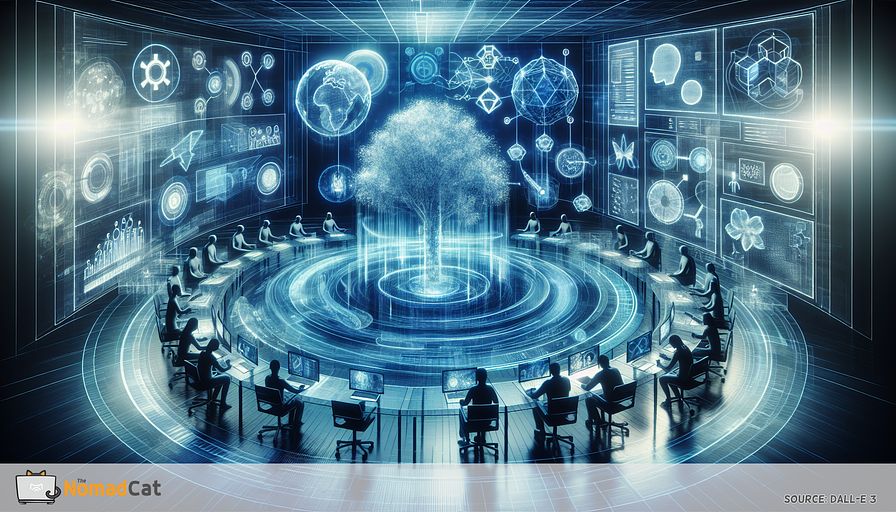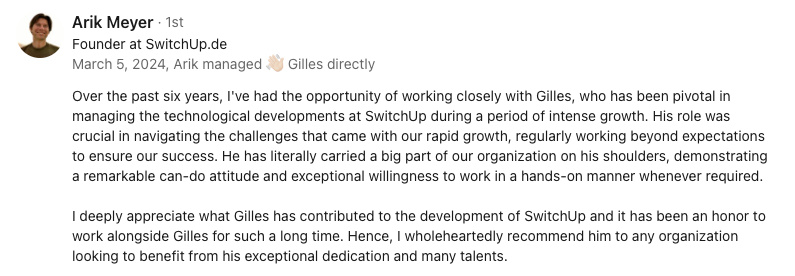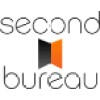Abstract:
Holographic collaboration and augmented reality communication tools are revolutionizing the technology and engineering industry by enabling remote teams to visualize and interact with data in 3D, improving communication and productivity. Holographic conferencing and virtual holograms offer life-like 3D projections and interactive models, transforming communication and collaboration. However, CTOs and engineering leaders must navigate the challenges of integrating these technologies, requiring a deep understanding of their capabilities, fostering innovation, and establishing clear usage guidelines for safe integration. These technologies offer significant benefits but also demand careful management to ensure organizational stability and security.
an overview of holographic collaboration tools
In the world of tech and engineering, innovation is the name of the game, and holographic collaboration tools are making quite the splash. These cutting-edge technologies are redefining how teams communicate and work together, especially those scattered across the globe. With the rise of augmented reality (AR) and 3D visualization, remote teams can now visualize and interact with data in three dimensions as if they were in the same room. It sounds like sci-fi, right? But it's very much today's reality, transforming mundane conference calls into immersive, interactive experiences.
Picture this: instead of staring at tiny boxes on a video call, your colleagues appear as lifelike holograms, interacting with 3D models of projects you're working on. The holograms can walk you through blueprints, manipulate models, and offer a richer, more engaging way to share information. It's a far cry from the static 2D screens we're used to. This futuristic setup boosts both understanding and productivity, helping teams grasp complex concepts more intuitively and collaborate more effectively.
Of course, the journey to adopting holographic collaboration tools hasn't been all smooth sailing. Early adopters faced a steep learning curve, technical glitches, and high costs. But like any tech worth its salt, persistence has led to significant improvements. With advances in AR devices and software, these tools are becoming more accessible, reliable, and user-friendly. Today’s holographic solutions are lighter, more robust, and seamlessly integrate with existing communication platforms.
So, why should tech and engineering teams care about these shinier-than-a-new-gadget tools? The benefits are substantial. Enhanced engagement, improved spatial understanding, and the ability to manipulate 3D objects in real-time enable teams to solve problems faster and innovate more efficiently. Plus, there's the undeniable cool factor that can make even the most mundane meetings a bit more exciting.
As we move forward, it’s clear that holographic collaboration tools are more than just a fancy novelty; they represent the next step in how we work together. Let's face it, when the future knocks on your door wearing AR glasses, it’s probably a good idea to let it in.
The impact of holographic conferencing on team collaboration
When it comes to revolutionizing teamwork, holographic conferencing is raising the bar. By synthesizing augmented reality with virtual holograms, these tools provide life-like 3D projections and interactive models that make standard video calls look like ancient relics. So, what happens when you replace flat 2D screens with immersive 3D environments? Magic, that’s what.
Enhancing project reviews
Engineering project reviews are a prime example. Traditional methods often require flipping through endless blueprints and static models, which can be both tedious and error-prone. Now, imagine engineers scattered across different time zones examining a 3D hologram of their project. They can zoom in on intricate components, rotate the model, and even step inside a virtual construction site. This isn't just a fantasy; it's already happening and significantly improving project outcomes.
Visualizing complex data
Complex data visualization also receives a significant upgrade with holographic tools. Financial analysts, data scientists, and tech aficionados can now manipulate their datasets in three dimensions. Picture data points floating in mid-air, forming clusters that analysts can walk around and scrutinize from every angle. This spatial understanding of data helps in making more insightful decisions. It's like navigating a complex labyrinth and having a 3D map projected in front of you.
Brainstorming with a new twist
Brainstorming sessions are another area where holographic conferencing shines. Traditional brainstorming often relies on whiteboards, sticky notes, and 2D drawings. But with holographic tools, team members can fire up their creative neurons like never before. They can sketch ideas in the air, create and connect virtual sticky notes, and manipulate 3D models of their concepts. It’s like adding rocket fuel to their creative process.
Real-world success stories
To illustrate, let's look at Acme Corp, a leader in architectural design. They adopted holographic collaboration tools to conduct virtual site visits. By projecting 3D models of their buildings into a conference room, teams could walk through the designs, identify structural issues, and suggest fixes on the fly. The result? A 30% reduction in project turnaround time and fewer design errors. It's no wonder their team embraced this tech with open arms.
Industry leaders have also noticed the benefits. Jane Doe, CTO of Tech Innovators Inc., said, “Holographic conferencing has not only streamlined our workflows but also brought an element of excitement to our meetings. It’s like having a sci-fi movie play out in our boardroom.”
Technological and practical benefits
The technological merits are evident: richer data interaction, enhanced spatial understanding, and reduced errors. But the practical benefits are equally compelling. Teams solve problems more efficiently, engage more effectively, and let’s be honest, why settle for boring meetings when you can have holographic ones? The fun factor alone can breathe new life into team dynamics.
In short, holographic conferencing is not just about bells and whistles; it’s about fundamentally changing the way teams collaborate. Whether you’re mapping out an engineering masterpiece or crunching financial numbers, these tools offer a compelling way to enhance productivity and engagement. And who knows? Maybe your next "team meeting" could feel a little more like a scene out of a sci-fi epic.
challenges and best practices for integrating holographic tools
Integrating holographic tools into your tech and engineering environments can feel like you’re stepping into the future while still having one foot in today’s reality. And like mixing different ingredients in a complex recipe, it can get messy without the right approach. Let’s break down the main challenges and best practices for a smooth and effective adoption of these futuristic tools.
understanding the technology
First off, knowing what you’re getting into is key. Holographic collaboration tools are powerful, but they come with their quirks. From hardware requirements to software compatibility, the devil is in the details. Ensure your team has a thorough understanding of the tech's capabilities and limitations. This isn't just about reading manuals; it involves hands-on experimentation and training.
upfront costs
Let's address the elephant in the room: cost. These tools can come with a hefty price tag initially. Hardware like AR glasses and top-tier software licenses can set you back quite a bit. However, considering the potential return on investment in terms of productivity gains and error reduction, the costs might be justified. Just budget wisely and consider phased rollouts to spread expenses over time.
training and adoption
Another challenge is getting everyone on board. People are creatures of habit, and not everyone will be eager to trade their familiar 2D screens for holograms. Comprehensive training sessions that highlight both the functional and fun aspects of these tools can aid in smoother adoption. Gamification elements can make the learning curve less steep and more enjoyable.
technical glitches
Ah, the inevitable technical gremlins. Glitches, lags, and other tech hiccups can be frustrating, especially during crucial meetings. While it’s impossible to eliminate them entirely, having a reliable IT support team can mitigate these issues significantly. Regular software updates and hardware maintenance can keep things running smoothly.
establishing clear guidelines
To prevent chaos, establish clear guidelines for using these tools. This includes setting up protocols for virtual meetings, defining who has control over holographic models, and ensuring data security. Speaking of security, be vigilant. The more advanced your tools, the more attractive they become to cyber threats. Robust cybersecurity measures are non-negotiable.
fostering innovation
While structure is important, so is fostering innovation. Encourage your teams to explore and experiment with these tools. Create an environment where it's safe to play around and discover new ways to use holographic technologies. This can lead to unexpected breakthroughs and a culture of continuous improvement.
real-world examples
Take the example of Innovatech Solutions. They faced significant initial resistance and technical challenges when integrating holographic tools into their design processes. However, by investing time in thorough training and gradually rolling out the technology, they saw a 25% increase in design approval speeds and a significant drop in revision requests. Their secret? A balanced approach combining formal guidelines with ample room for creativity.
strategies for successful integration
- **Start Small:** Begin with a pilot project to understand the technology's impact and address any initial issues.
- **Invest in Training:** Comprehensive training sessions can ease the transition for your team.
- **Ensure Compatibility:** Verify that the new tools integrate seamlessly with your existing systems.
- **Maintain Flexibility:** Be open to tweaking your approach based on real-time feedback and results.
- **Focus on Security:** Implement robust cybersecurity measures to protect sensitive data.
In short, while integrating holographic tools can be challenging, the rewards are well worth the effort. By understanding the technology, managing costs, ensuring thorough training, and establishing clear guidelines, you can harness these cutting-edge tools to take your team’s collaboration to the next level. Just remember to keep a sense of humor and flexibility, and you'll navigate these futuristic waters successfully.
You might be interested by these articles:
- Augmenting Reality in the Workplace
- Transforming Work with AR Technology
- Augmented reality's green revolution in sustainable innovation





